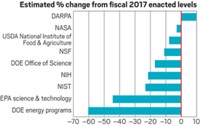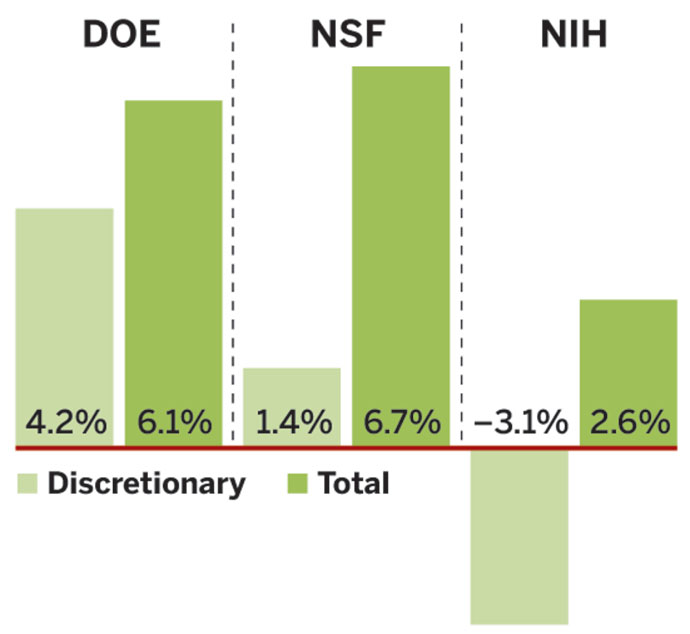Advertisement
Grab your lab coat. Let's get started
Welcome!
Welcome!
Create an account below to get 6 C&EN articles per month, receive newsletters and more - all free.
It seems this is your first time logging in online. Please enter the following information to continue.
As an ACS member you automatically get access to this site. All we need is few more details to create your reading experience.
Not you? Sign in with a different account.
Not you? Sign in with a different account.
ERROR 1
ERROR 1
ERROR 2
ERROR 2
ERROR 2
ERROR 2
ERROR 2
Password and Confirm password must match.
If you have an ACS member number, please enter it here so we can link this account to your membership. (optional)
ERROR 2
ACS values your privacy. By submitting your information, you are gaining access to C&EN and subscribing to our weekly newsletter. We use the information you provide to make your reading experience better, and we will never sell your data to third party members.
Policy
NIH: Funding Is Flat, But Translational Science Grows
by Britt E. Erickson
February 27, 2012
| A version of this story appeared in
Volume 90, Issue 9
Under the proposed fiscal 2013 budget, the National Institutes of Health would receive $30.8 billion, the same amount enacted for 2012. The agency plans to concentrate on basic biomedical research, support for new investigators, and translational science.
The National Center for Advancing Translational Sciences (NCATS) is the only one of NIH’s 27 institutes and centers that would see a meaningful budget increase in 2013. NCATS is a new center focused on accelerating drug development (C&EN, Feb. 14, 2011, page 25). The center would see an 11.1% increase compared with 2012, bringing its total 2013 budget to $639 million.
The proposed NCATS budget includes $50 million for the Cures Acceleration Network (CAN), up $40 million from 2012. The program was authorized under the health care reform bill of 2010, but wasn’t funded until 2012 (C&EN, Jan. 9, page 29). CAN aims to lower barriers between drug discovery and clinical trials and speed up the development of cures and treatments for various diseases.
To offset the increases, the National Children’s Study—funded by the Office of the Director—would lose $28 million or 14.4%, bringing its budget down to $166 million for fiscal 2013. The study plans to follow 100,000 U.S. children from before birth until age 21 to examine how genetics and environmental factors—such as air, water, diet, sound, and family dynamics—affect health.
The National Institute of General Medical Sciences (NIGMS), the top NIH institute for the support of chemical research, would see a 2.0% decrease in 2013 compared with 2012. Most of the cuts, or $51 million, would be directed at NIH’s Institutional Development Awards program, which aims to broaden the geographic distribution of NIH grants by funding investigators in states where success rates for NIH grants have been historically low. NIGMS got a 2.6% funding boost in 2012 to support the program.
NIH expects to support 35,888 grants in 2013, down slightly from 35,944 in 2012. The agency estimates that 9,415 of the grants in 2013 will be new and competing awards, an increase of 672 grants or 7.1% compared with 2012. To pay for the new grants, NIH plans to cut some existing grants by 1%. NIH’s goal is to boost success rates, which are currently hovering around an all-time low of 18%.
NIH advocates and health organizations are disappointed with the President’s flat budget request for NIH. “The Administration’s proposal to freeze the budget for NIH would mean that the NIH budget has failed to keep pace with biomedical inflation for 10 consecutive years,” says Darrell G. Kirch, president and chief executive officer of the Association of American Medical Colleges. That situation “would have dramatic consequences on the pace of medical innovation and harm communities around the nation,” he notes.
If the proposed budget for NIH is enacted, “researchers will leave the field, potential breakthroughs will be shelved, and new business opportunities grounded in medical discovery will evaporate as research institutions struggle with leaner budgets,” says Mary Woolley, president and chief executive officer of Research!America, a group that advocates for increased investments in federal R&D. A frozen budget for NIH will also “flatline medical breakthroughs in the coming years and stifle the business and job creation that begins with research and development,” she says.
MORE ON THIS STORY
- - NSF: PRESIDENT MAINTAINS GROWTH FOR CORE RESEARCH
- - NIH: FUNDING IS FLAT, BUT TRANSLATIONAL SCIENCE GROWS
- - DEFENSE: SCIENCE & TECHNOLOGY HOLD THEIR OWN
- - DHS: SCIENCE & TECHNOLOGY OFFICE GETS RAISE
- - ENERGY: MORE DOLLARS FOR CLEAN AND RENEWABLE ENERGY R&D
- - COMMERCE: R&D FUNDING IS UP AT NIST, DOWN AT NOAA
- - AGRICULTURE: RESEARCH FUNDS DECLINE
- - EPA: FUNDS FOR SCIENCE & TECHNOLOGY UP
- - NASA: PLAN SCALES BACK MARS EXPLORATION ACTIVITIES
- - INTERAGENCY INITIATIVES: EDUCATION, CLIMATE SCIENCE, NANOTECH ALL GROW






Join the conversation
Contact the reporter
Submit a Letter to the Editor for publication
Engage with us on Twitter